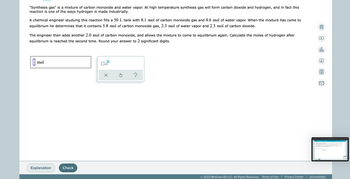Nitrogen dioxide is one of the many oxides of nitrogen (often collectively called "NOx") that are of interest to atmospheric chemistry. It can react with itself to form another form of NOx, dinitrogen tetroxide. A chemical engineer studying this reaction fills a 2.0 L flask with 3.7 atm of nitrogen dioxide gas. When the mixture has come to equilibrium she determines that contains 2.4 atm of nitrogen dioxide gas. Ⓡ The engineer then adds another 1.2 atm of nitrogen dioxide, and allows the mixture to come to equilibrium again. Calculate the pressure of dinitrogen tetroxide after equilibrium is reached the second time. Round your answer to 2 significant digits. do atm 0 X S ?
Nitrogen dioxide is one of the many oxides of nitrogen (often collectively called "NOx") that are of interest to atmospheric chemistry. It can react with itself to form another form of NOx, dinitrogen tetroxide. A chemical engineer studying this reaction fills a 2.0 L flask with 3.7 atm of nitrogen dioxide gas. When the mixture has come to equilibrium she determines that contains 2.4 atm of nitrogen dioxide gas. Ⓡ The engineer then adds another 1.2 atm of nitrogen dioxide, and allows the mixture to come to equilibrium again. Calculate the pressure of dinitrogen tetroxide after equilibrium is reached the second time. Round your answer to 2 significant digits. do atm 0 X S ?
Chemistry for Engineering Students
4th Edition
ISBN:9781337398909
Author:Lawrence S. Brown, Tom Holme
Publisher:Lawrence S. Brown, Tom Holme
Chapter12: Chemical Equilibrium
Section: Chapter Questions
Problem 12.101PAE: 12.101 An engineer working on a design to extract petroleum from a deep thermal reservoir wishes to...
Related questions
Question
100%

Transcribed Image Text:Nitrogen dioxide is one of the many oxides of nitrogen (often collectively called "NOx") that are of interest to atmospheric chemistry. It can react with itself to
form another form of NOx, dinitrogen tetroxide.
A chemical engineer studying this reaction fills a 2.0 L flask with 3.7 atm of nitrogen dioxide gas. When the mixture has come to equilibrium she determines
that it contains 2.4 atm of nitrogen dioxide gas.
The engineer then adds another 1.2 atm of nitrogen dioxide, and allows the mixture to come to equilibrium again. Calculate the pressure of dinitrogen tetroxide
after equilibrium is reached the second time. Round your answer to 2 significant digits.
00.
Ar
atm
x10
Ś
?
Explanation
© 2022 McGraw Hill LLC. All Rights Reserved. Terms of Use | Privacy Center | Accessibility
Check
A
。
Expert Solution
This question has been solved!
Explore an expertly crafted, step-by-step solution for a thorough understanding of key concepts.
Step by step
Solved in 3 steps with 2 images

Follow-up Questions
Read through expert solutions to related follow-up questions below.
Follow-up Question
can u answer this, its asking for mols

Transcribed Image Text:"Synthesis gas" is a mixture of carbon monoxide and water vapor. At high temperature synthesis gas will form carbon dioxide and hydrogen, and in fact this
reaction is one of the ways hydrogen is made industrially.
A chemical engineer studying this reaction fills a 50 L tank with 8.1 mol of carbon monoxide gas and 4.6 mol of water vapor. When the mixture has come to
equilibrium he determines that it contains 5.8 mol of carbon monoxide gas, 2.3 mol of water vapor and 2.3 mol of carbon dioxide.
The engineer then adds another 2.0 mol of carbon monoxide, and allows the mixture to come to equilibrium again. Calculate the moles of hydrogen after
equilibrium is reached the second time. Round your answer to 2 significant digits.
mol
x10
X
S
?
Explanation
© 2022 McGraw Hill LLC. All Rights Reserved.
Check
000
Ar
81
KI
Terms of Use | Privacy Center | Accessibility
Solution
Knowledge Booster
Learn more about
Need a deep-dive on the concept behind this application? Look no further. Learn more about this topic, chemistry and related others by exploring similar questions and additional content below.Recommended textbooks for you

Chemistry for Engineering Students
Chemistry
ISBN:
9781337398909
Author:
Lawrence S. Brown, Tom Holme
Publisher:
Cengage Learning

Chemistry
Chemistry
ISBN:
9781305957404
Author:
Steven S. Zumdahl, Susan A. Zumdahl, Donald J. DeCoste
Publisher:
Cengage Learning


Chemistry for Engineering Students
Chemistry
ISBN:
9781337398909
Author:
Lawrence S. Brown, Tom Holme
Publisher:
Cengage Learning

Chemistry
Chemistry
ISBN:
9781305957404
Author:
Steven S. Zumdahl, Susan A. Zumdahl, Donald J. DeCoste
Publisher:
Cengage Learning


Chemistry: An Atoms First Approach
Chemistry
ISBN:
9781305079243
Author:
Steven S. Zumdahl, Susan A. Zumdahl
Publisher:
Cengage Learning

World of Chemistry, 3rd edition
Chemistry
ISBN:
9781133109655
Author:
Steven S. Zumdahl, Susan L. Zumdahl, Donald J. DeCoste
Publisher:
Brooks / Cole / Cengage Learning

Chemistry: Principles and Reactions
Chemistry
ISBN:
9781305079373
Author:
William L. Masterton, Cecile N. Hurley
Publisher:
Cengage Learning